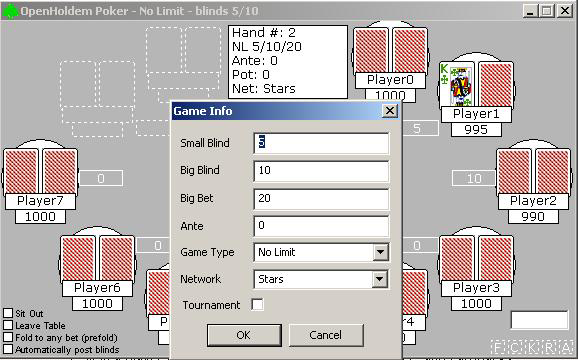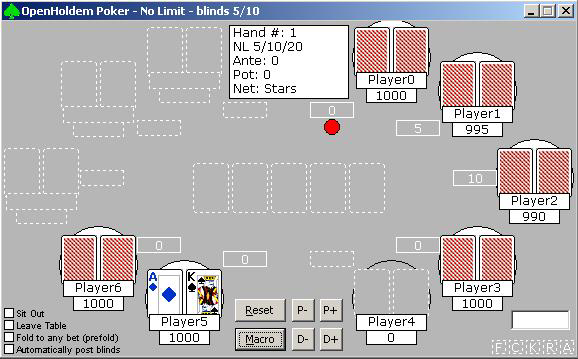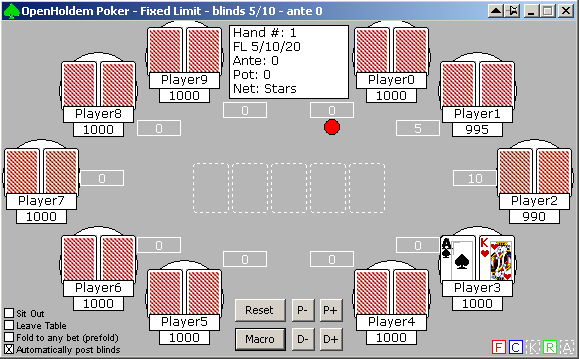↓ManualMode
Description
ManualMode is a tool for simulating a poker game state offine. It allows you to set any game state you can think of, including your cards, buttons, etc.
A Table Map is included with the ManualMode tool to allow OpenHoldem to connect to the ManualMode main window and scrape the game state 100% correctly into the OpenHoldem engine. This will allow for offline construction of bot logic and the easy setup of various game state situations, some of which are very rare online (think Straight Flushes).
Familiarizing yourself with ManualMode
The ManualMode interface is quite intuitive. All relevant elements on the poker table are visible at all times, either populated with objects (like cards or bets), or outlined in white dashed lines if not populated. Each game state element is interacted with slightly differently and is discussed below. In general, however, right-clicking on any element will bring up a list
- Common Cards: Right-clicking on each common card will bring up a context
- Sit Down/Stand Up: OpenHoldem recognizes the difference between sitting in at a chair, and sitting in a game and being dealt a hand. allowing the player to Sit Down or Stand Up from the selected chair.
- Sit In/Sit Out: OpenHoldem recognizes the difference between sitting in at a chair, and sitting in a game and being dealt a hand. cards will bring up a context menu allowing the player to Sit In to the game or Sit out from the game. table. up a context menu allowing the assignment of the dealer button to the selected chair. around the table anti-clockwise or clockwise.
- Player Cards: Right-clicking on either of a player’s cards will bring up a context menu allowing the selection of rank/suit, “cardbacks” or “no card”. Note: prior to assigning cards, a player must have “Sat In” the game.
- Player Names: Right-clicking on the player’s name rectangle will pop up a window prompting for a string to use as the player’s name. Note: prior to assigning names, a player must have “Sat Down” at the table.
- Player Balances: Right-clicking on the player’s balance rectangle will pop up a window prompting for a string to use as the player’s balance. Note: prior to assigning balances, a player must have “Sat Down” at the table.
- Player Bets: Right-clicking on the player’s bet rectangle will pop up a window prompting for a string to use as the player’s bet. Note: prior to assigning bets, a player must have “Sat In” the game.
- Dealer Button: Right-clicking on either of a player’s cards will bring up a context menu allowing the assignment of the dealer button to the selected chair. The “D-” and “D+“ buttons can also be clicked to move the dealer button around the table anti-clockwise or clockwise.
- Blinds/Limits: Right-clicking on the center information box will pop up a window in which the small blind, big blind, big bet, ante, game type (FL, PL, NL), network (useful if integrating with {PokerTracker}), and tournament indicator can be set. Buttons: Left-clicking on any game-state button on the table will toggle its state from on to off. These include the FCKRA buttons on the bottom right (fold, call, check, table, prefold, autopost).
There are some shortcuts built into ManualMode to allow easier setup of from the table. As players are added, they will Sit Down, Sit In, and will be assigned a name and balance. Players will be added from chair 0 to chair 9, depending on what is open, and removed in reverse order. for a string to be entered. The format of the macro string is described here at the bottom of this page. Betting: Left-clicking (right click to set a specific bet amount).
Note: When ManualMode detects a betting round change (i.e. 0 to 3, 3 to 4 or 4 to 5 common cards), then all player bets will be collected into the pot, and all player bets will be reset to zero.
Defining the game-type
If you right-clicking at the “white box” ManualMode will show a dialog where you can set up the gametype to be simulated.

Macros

A macro string is a series of characters executed one at a time, left to right. The meaning of each character is as follows:
|
Character
|
Meaning |
| R (uppercase) |
Reset the game state
|
| N (Uppercase) | Set the dealer button to this chair |
| P (uppercase) | Sit in a player at this chair, default name, default balance, and cardbacks |
| p (lowercase) | Unseat a player at this chair |
| b (lowercase) | Set the small blind at this chair |
| B (uppercase) | Set the big blind at this chair |
| 23456789tjqka |
Set the rank of the players cards at this chair, or common cards
User cards have to be immediatelly after the player in question, all additional cards will be considered common cards. |
| cdhs | See the suit of the players cards at this chair, or common cards (player first, common next) |
The default macro provided (“RNbBPpPAdKsP”) used in the image above will
- reset (R) the table
- set the button (N) to chair 0
- set the small blind (b) to chair 1
- set the bigl blind (B) to chair 2
- set another player (P) to chair 3
- set an empty chair (p) to chair 4
- set another player (P) — the user! — to chair5 and deal him an ace of diamonds and a king of spades (AdKs)
- set another player (P) to chair 6
- finally leave the last 3 chairs will stay empty
Document generated by eLyXer 1.2.5 (2013-03-10) on 2015-07-27T11:32:13.750000
